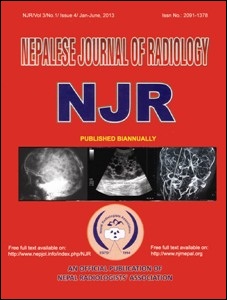Computed Tomographic Evaluation of Posterior Fossa Lesions
DOI:
https://doi.org/10.3126/njr.v3i1.8796Keywords:
Computed Tomography, Posterior Fossa Lesions, TumorsAbstract
Background: Various neoplastic and nonneoplastic lesions can involve posterior cranial fossa. Posterior fossa lesions are potentially fatal since they may result in compression of the brainstem. The objective of this study was to analyze the spectrum of posterior fossa lesions and their clinical presentations.
Methods: A prospective cross sectional study was conducted over a period of one year. Thirty patients with clinical features of posterior fossa pathology, referred for cranial computed tomography, were evaluated in the study.
Results: Posterior fossa lesions found in this study were cerebellar abscess- 4(13.3%), arachnoid cyst- 4(13.3%), brainstem glioma- 3(10%), cerebellar astrocytoma- 3(10%), acute cerebellar infarct- 2(6.7%), cerebellar metastasis- 2(6.7%), acoustic neuroma- 2(6.7%), meningioma- 2(6.7%), medulloblastoma- 2(6.7%), ependymoma- 1(3.3%), Dandy-Walker malformation- 1(3.3%), 4th ventricular bleed- 1(3.3%), brainstem haemorrhage- 1(3.3%), cerebellar haemorrhage- 1(3.3%), and neurocysticercosis- 1(3.3%). The maximum numbers of cases (23.3%) with posterior fossa lesions were in their first decade of life. Features of raised intracranial pressure (i.e. headache, nausea & vomiting) were the commonest presenting symptoms. Other symptoms included altered sensorium, ataxia, fever, limb weakness, vertigo, seizure, hearing loss, neck stiffness, slurring of voice, ear discharge, tinnitus, loss of consciousness and macrocrania in decreasing order of frequency.
Conclusion: There is wide spectrum of the lesions in posterior fossa in children and adults in this part of Nepal, requiring prompt diagnosis and intervention, and CT has a pivotal role in the management.
Nepalese Journal of Radiology / Vol.3 / No.1 / Issue 4 / Jan-June, 2013 / 53.58
Downloads
Downloads
Published
How to Cite
Issue
Section
License
This license enables reusers to distribute, remix, adapt, and build upon the material in any medium or format, so long as attribution is given to the creator. The license allows for commercial use.




